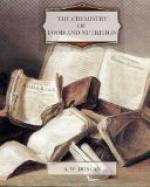Some valuable investigations were made on the diet of a family of fruitarians, at the Californian Agricultural Experimental Station, July, 1900, by Professor M.E. Jaffa (bulletin 107). The proportion of food, both proteid and carbo-hydrate used was surprisingly small. The research is particularly important, as the diet was not an experimental one, tried during a short period only; but that to which the family were accustomed. The family consisted of two women and three children; they had all been fruitarians for five to seven years, and made no change in their dietary during the experiment. They only had two meals a day, the food being eaten uncooked. The quantities of all the foods and other particulars are detailed in the bulletin. The first meal was at 10-30 a.m., and always consisted of nuts followed by fruits. The other meal was about 5 p.m., when they usually ate no nuts, substituting olive oil and honey. The nuts used were almonds, Brazil, pine, pignolias and walnuts; the fresh fruits were apples, apricots, bananas, figs, grapes, oranges, peaches and pears. Other foods were dates, raisins, pickled olives, olive oil and honey. One person (b) ate a little celery and tomatoes, and another (c) a little cereal food. In the following table are given the average daily quantities of the food constituents in grammes:—Proteids, fat, carbo-hydrate, crude fibre, value in calories and nutrient ratio. The crude fibre is classed as a carbo-hydrate and included in the calorie value, and also in calculating the nutrient ratio.
Pro. Fat. C’r’b. Fibre. Cal. N. R. Woman, age 33, weight 90 lbs. (a) 33 59 110 40 1300 8.6 Woman " 30 " 104 " (b) 25 57 72 27 1040 9.1 Girl " 13 " 75-1/2 " (c) 26 52 111 46 1235 10.5 Boy " 9 " 43 " (d) 27 56 102 50 1255 10.3 Girl " 6 " 30-1/2 " (e) 24 58 97 37 1190 11.1 Girl " 7 " 34 " (ee) 40 72 126 8 1385 7.4
The last research extended over ten days; the period during which each of the other subjects was under observation was from 20 to 28 days.




